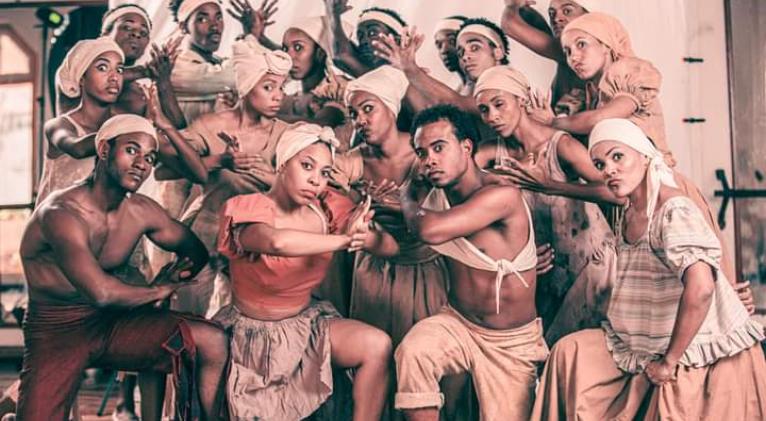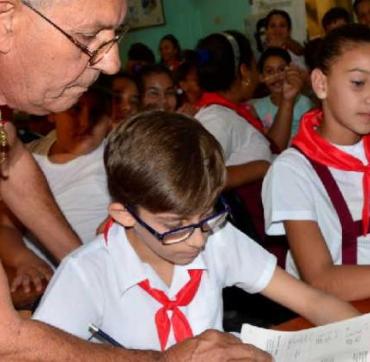Comunidad: renewing from tradition
especiales

Time is growing short these days at the National Folklore Ensemble. The most ambitious project of the company in recent years is being rehearsed. The group’s young director, first dancer Leivan García, is the choreographer of Comunidad, a big show that shall get the stage of the Avellaneda Hall of the National Theater of Cuba by May 3rd.
It is not easy at all. This is a comprehensive staging, in which various artistic expressions and formats will come together. And it will stand, in some way, as an example of the renewal process the main company of popular and traditional Cuban dances is heading to in its stage projection.
García confirms that Comunidad aims to paying homage to the first show of the National Folkloric Ensemble of Cuba, in 1963.
“We set out to investigate the ensemble's repository, its shows, creative processes and tradition as likely sources for the show staging. We tried to systematize a form of corporal and creative training that would contribute to the aesthetic renewal of folk dance based on other scenic sources," he says.
To achieve it —he believes—, it was mandatory to seek for modern methods on new sound, musical, and visual possibilities for folk dance with the purpose of creating outstanding and dramatic structures that may pave the way to suitable convergence of dance, theater, and audiovisual.
As you see, it is very challenging. Leivan believes it is imperative to open spaces to new interdisciplinary staging products from a more contemporary aesthetic of folk dance.
The much talked debate about the contemporaneity of stage folk dance. Leiván García is a regular participant in colloquiums and panels on the subject. But doing is the best way of saying.
“Here, we intend to explore the limits between classical and folkloric, dance, theater and audiovisual. The work will address critical issues of our culture to expose and question them through fiction and movement, music and image.”
Faced with the prospect of the staging, García asked himself several questions. “Folk dance will always demand from the body a very particular energy, presence and plasticity in the scene, but how does this mystical, technical and aesthetic language result in contemporaneity without losing its origins? How to establish a critical discourse in the face of racism and other problems of our time?”
“It's not just about skin color. Customs, beliefs, history itself and the artistic approach somehow relates to the racism that co-exists in the dance scene. Many times explicitly; others, by less visible paths.”
“The "shackles" enslave us again, now iron and leather punish languages and manners, shows, and even cultural policies.”
It may seem like an extreme claim, assuming the forcefulness of public policies on the matter. But the law is much more than paper. And art can contribute.
The struggle is also aesthetic, and these are times of interdisciplinary approaches.
“That is why traditional music will coexist with classical orchestration. Together they will reveal the Congo mysteries, traditional rhythms and songs. The National Symphony Orchestra, together with maestro Alejandro Falcón, will perform a three-movement piece. The inspiration for that piece is in the traditional music belonging to the religious cult known in Cuba as Regla Palo-monte. The National Choir, under Maestro Digna Guerra, will recreate the traditional songs of one of the art manifestations that came to Cuba from Bantu land: The Yuka.
Nobody has considered a break with tradition. But tradition is not an immovable entity. The company has to keep up with times.
“The original meaning of the National Folkloric Ensemble of Cuba was the research work on the cultural roots. And attention was always paid to present times, which is evidence of the historical and social changes, which inevitably affect the viewer and require the scene to conceive new ways of thinking about its staging.”
“It is necessary to question the relationship between the audience and the National Folkloric Ensemble of Cuba, address the lack of interest of the new creators in recovering the creative strength that identified the institution in its first twenty years, recognize the management capacity and the great choreographic achievements, and recover the space that corresponds to a national company.”
Leiván García is not alone in facing so many challenges. He feels supported by his team: dancers, teachers, and technicians.
"These days, it is mandatory to rebuild oneself as a creator. We must rethink the processes to give a new meaning to stage work."
That is where Comunidad goes..., we should see the way in which it opens its own path.
The show will be staged on May 3 and 4.
Translated by Sergio A. Paneque Díaz / CubaSí Translation Staff














Add new comment